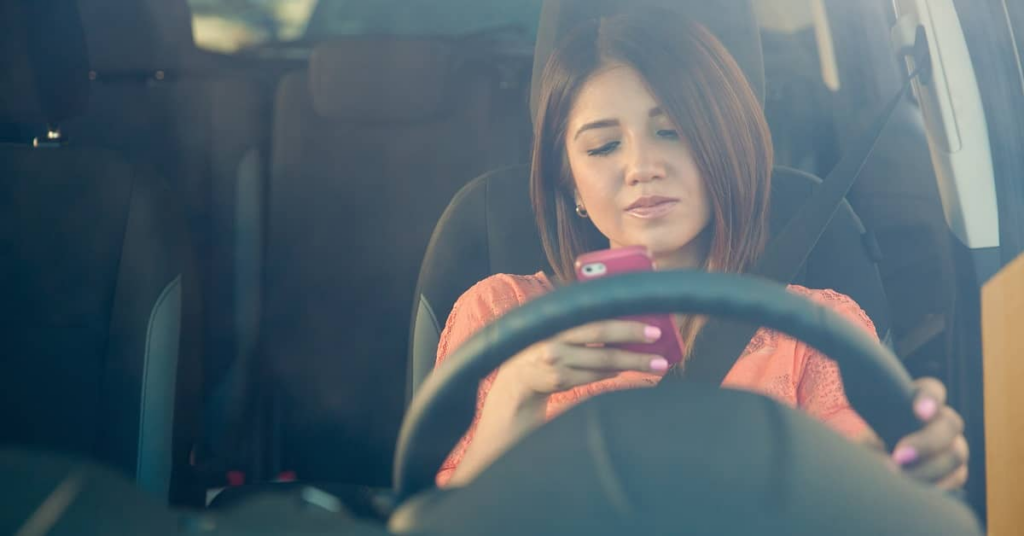
Distracted driving is a major problem in the United States. Nationally, accidents involving distracted drivers account for nearly 10 percent of all fatalities in motor vehicle crashes.
Each April, Distracted Driving Awareness Month draws attention to this serious issue. This year the National Highway Traffic Safety Administration is raising awareness of the problem through a campaign that draws attention to the laws states have passed to combat distracted driving: U Drive. U Text. U Pay.
Although 48 states (including Connecticut) have passed laws to curb distracted driving, this reckless behavior still poses a threat to motorists, pedestrians, and bicyclists. No one can control the actions of another driver, but you can take steps on your own to reduce the risk of a crash.
If you suspect driver distraction was a factor in a crash, speak to a distracted driving accident attorney at The Flood Law Firm in Middletown, Danbury, Waterbury, or Bridgeport. Your initial consultation is free.
How to Reduce Your Risk of Distraction
Most distractions arise as a result of multitasking. Drivers often feel like there are not enough hours in the day, so they use their time behind the wheel to complete other tasks.
However, driving is an act that demands our full attention. If your eyes and mind aren’t focused on the road and your hands aren’t on the wheel, you are at risk of getting into an accident.
Steps you can take to limit the likelihood of driving distracted include:
1. Silence and Store Your Cell Phone
Cell phone use is not the only cause of distracted driving, but it is the most prominent source. In Connecticut, it is illegal to text or talk on a handheld phone while driving (except to make phone calls in emergency situations).
Before every trip, set your phone on “Silent” so you don’t feel tempted to answer a call or text. There are even apps you can download to your phone that silence notifications and automatically respond to let people know that you are driving. For added safety, consider placing your phone in the glovebox or center console so the device is entirely out of sight.
2. Don’t Eat or Drink on the Go
Carve out time in the morning and afternoon for meals and snacks. Holding food and beverages while driving limits your control of the vehicle and may be visually distracting as well.
If you do have a drink in the car, avoid reaching down to take a sip while you are in motion. Wait until you are stopped, such as sitting at a red light, before taking a drink.
3. Limit Distractions Inside the Car
Even if your hands are at 10 and 2, your mind may be somewhere else. These distractions can take many forms, including:
- Adjusting the air conditioning or heat
- Changing stations or adjusting volume on the radio
- Reaching to secure loose objects inside the car
- Adjusting mirrors
- Checking maps and GPS
Once again, it is best to perform these activities before you start driving. If you need to make adjustments in the course of a trip, wait until you come to a complete stop.
4. Manage Your Passengers
Issues such as loud talking, singing, and rowdy behavior by passengers can all prove distracting for drivers. Never hesitate to speak up if your passengers are making it difficult for you to focus on driving the car.
When transporting children or pets, make sure kids are properly restrained and pets are loaded in the back before you start to drive. If a situation arises, pull over or park the car.
5. Avoid Rubbernecking
A large number of crashes occur because drivers get caught up looking at the scene of another accident. Though it is important to be aware of potential hazards on the road ahead (including traffic that is slowed or stopped due to an accident), your focus should be the safe operation of your vehicle, not the misfortune of another driver.
How to Avoid Distracted Driving Accidents
In addition to modifying your behavior, there are additional steps you can take to be mindful of drivers who may be distracted. Though a distracted driver may not notice you, diligence on your part can avert an accident.
Watch out for the following when you are on the road:
1. Drifting
Distracted drivers have difficulty staying within the lane. When drivers are not looking at the road, their vehicles may drift into another lane or even into oncoming traffic.
Leave plenty of room between your vehicle and other vehicles drifting in and out of a lane, especially if the driver swerves or overcorrects. These behaviors may be an indication that the driver is distracted, or they could be connected to other issues (such as drunk driving).
2. Irregular Speed
Sudden increases and decreases in speed are another possible indicator of driver distraction. Distracted drivers may be unaware of changes in the speed limit, causing them to go too fast, or they may unconsciously fall below the speed limit, increasing the risk of a rear-end collision.
Diligence is the key to avoiding accidents with both speeding drivers and slow drivers. Watch the road in front of you carefully and check your mirrors for vehicles coming up behind you.
3. Delayed Reactions
In some cases, distracted drivers may look up just in time to see a stop sign, red light, or a vehicle in front of them. They may be able to avoid the obstacle or stay out of the intersection by swerving or slamming on their brakes, but evasive action is not always possible.
Any time you come up to an intersection, be sure to look in all directions. These extra seconds can mean the difference between getting through the intersection safely and being struck by an inattentive driver.
4. Errors in Turning
Distracted drivers face a number of issues when trying to execute a turn. They might take a corner too wide, fail to engage their turn signals, or slam on their brakes to avoid missing a turn.
No matter the exact behavior, these issues are another reason to use caution at intersections. Distracted drivers are unpredictable, and a variety of different accidents can happen when they are trying to turn.
5. Visible Distractions
Many signs of distracted driving are inferred from the behavior of the driver. However, if you glance at the car next to you or look in the rearview mirror, you might actually see drivers looking at their phones, eating, applying makeup, and more.
Obviously, if you witness any of these signs of distraction, you should try to keep clear of the vehicle. In the event of an accident with the distracted driver, tell the police and reach out to an accident attorney to share what you saw immediately before the crash.
Hit by a Distracted Driver? Contact an Attorney Today
Distracted driving accidents result in hundreds of thousands of injuries and thousands of fatalities every year. If you or a loved one suffered injury in an accident caused by a distracted driver, you deserve compensation for your losses.
At The Flood Law Firm, we pride ourselves on the results we achieve for our clients. Our reputation as formidable litigators often enables us to secure favorable settlements without going to court. However, we will never hesitate to go to trial if it means obtaining the best outcome in your case.
Please call The Flood Law Firm at (860) 346-2695 today for a free case evaluation. Our distracted driving accident attorneys have offices in Middletown, Danbury, Waterbury, and Bridgeport, and we serve clients throughout Connecticut.
